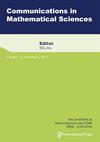High friction limits of Euler–Navier–Stokes–Korteweg equations for multicomponent models
IF 1.3
4区 数学
Q2 MATHEMATICS, APPLIED
引用次数: 0
Abstract
In this paper we analyze the high friction regime for the Navier Stokes Korteweg equations for multicomponent systems. According to the shape of the mixing and friction terms, we shall perform two limits: the high friction limit toward an equilibrium system for the limit densities and the barycentric velocity, and, after an appropriate time scaling, the diffusive relaxation toward parabolic, gradient flow equations for the limit densities. The rigorous justification of these limits is done by means of relative entropy techniques in the framework of weak, finite energy solutions of the relaxation models, rewritten in the enlarged formulation in terms of the drift velocity, toward smooth solutions of the corresponding equilibrium dynamics. Finally, since our estimates are uniform for small viscosity, the results are also valid for the Euler Korteweg multicomponent models, and the corresponding estimates can be obtained by sending the viscosity to zero.多分量模型的Euler-Navier-Stokes-Korteweg方程的高摩擦极限
本文章由计算机程序翻译,如有差异,请以英文原文为准。
求助全文
约1分钟内获得全文
求助全文
来源期刊
CiteScore
1.70
自引率
10.00%
发文量
59
审稿时长
6 months
期刊介绍:
Covers modern applied mathematics in the fields of modeling, applied and stochastic analyses and numerical computations—on problems that arise in physical, biological, engineering, and financial applications. The journal publishes high-quality, original research articles, reviews, and expository papers.

 求助内容:
求助内容: 应助结果提醒方式:
应助结果提醒方式:


